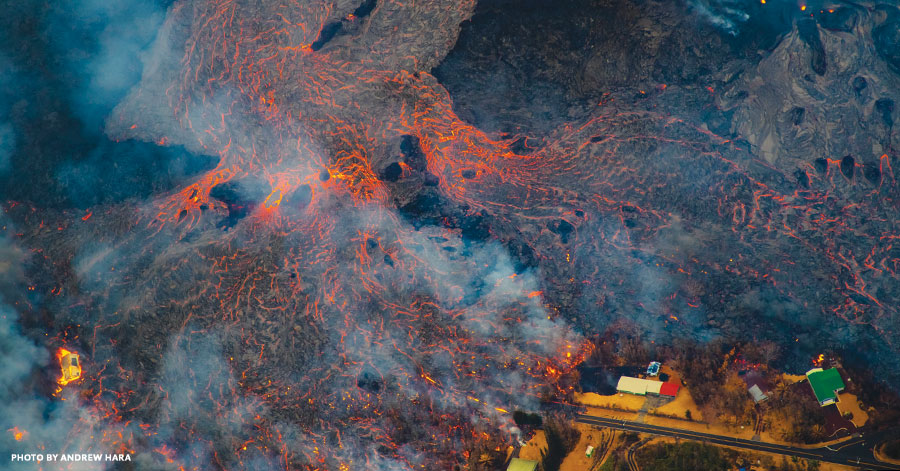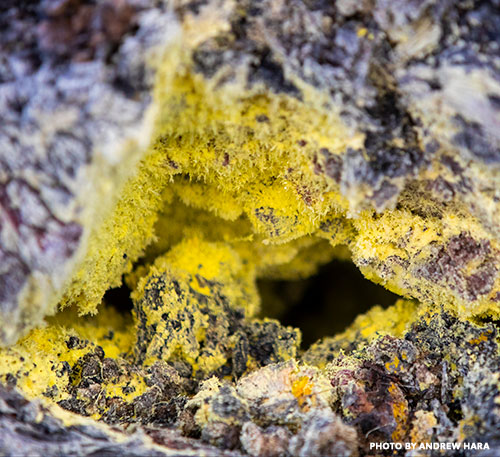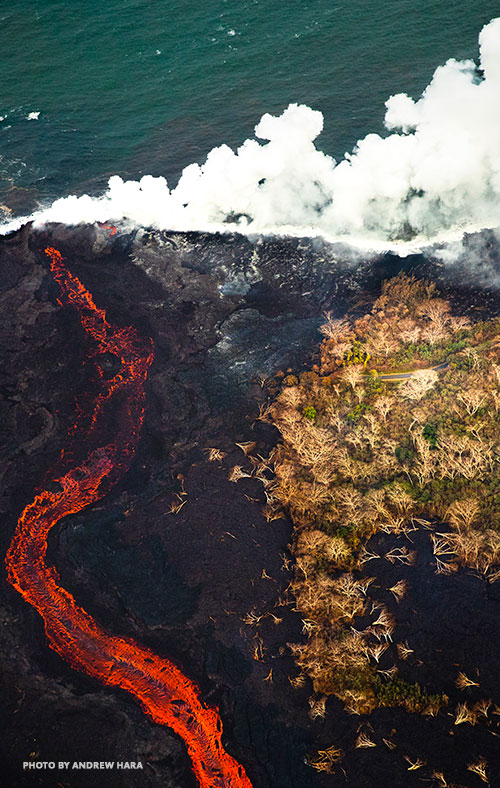
On May 28th, having watched countless videos of the Leilani eruption from every source I could find, and hearing from the many friends and acquaintances who had had to evacuate the neighborhood or scramble to help their friends and family evacuate, I had to understand this eruption viscerally, to see it, to feel it. I decided to fly over the eruption by helicopter. First, let me say that even Kīlauea’s mildest flows, the ones you can sit near, or walk by, or stand a few feet away from and photograph, feel animate, intentional. The science part of my brain understands perfectly well that I am looking at melted rock. The part of me that has been in Hawai‘i, bounded by Hawaiian culture, since 1994, has a sense of something else going on. The English language fails me a bit here. If a two-foot-thick lava flow feels alive, what I saw from my aerial perch belonged to the realm of gods and goddesses. Every Pele chant I have ever heard crowded into my mind as I looked down on 300-foot twin curtains of brilliant, hot-orange lava, and below that, a flow that kept outpacing itself—emerging so fast and hot that the front of the flow, much taller than the houses it was devouring, rolled forward like tank treads, the top rolling over the base. The flows reached forward like enormous, cracking, black and red hands, their fingers spreading wide where vegetation burned like twinkling holiday lights. The lava seemed to claw the ground, pulling itself forward.

All of the terms I’d heard in Pele chants, of grabbing and grasping, of the ground being eaten, flooded my mind as our metal hummingbird hung in the air. I was suddenly aware that I was yelling into my hands, which were cupped in front of my face in overwhelm. I don’t know what I was yelling. I do know that I was swept with a sense of our tiny, tiny, human scale. What was unfolding far below us was so powerful, so vast, and so clearly just beginning. Energy born in the volcano’s molten depths fought to unleash itself. From our vantage 3,000 feet in the air, we looked down at shimmering black and hot gold and blood red in motion, houses bursting into startled fire at the margins of the thick and spreading lake of liquid stone.
GOOD NEIGHBORS

An ocean channel thirty miles wide separates Maui and Hawai‘i Island, but in the wake of Kīlauea’s eruption, no distance has proved too great for aloha.
One of the larger efforts to kōkua (help) the “Big Island’s” Puna District is Kōkua Puna, organized to send much-needed items to evacuees. In May, the Maui community rallied to Kōkua Puna’s mission, filling a twenty-foot shipping container with tents, cots, sleeping bags, coolers, flashlights, batteries, cellphone chargers, bottled water, first-aid kits and more. Maui businesses donated supplies and financial support, helping to create “a big gift box of aloha from Maui.”
Hana hou translates as “Do it again,” and do it again, they did. In June, the Hana Hou Kōkua Puna filled a second container to overflowing.
And on July 8, Maui Tropical Plantation hosted Project Kōkua, a fundraiser for residents displaced or made homeless by the eruption. Held in partnership with the Rotary Club of Maui, Project Kōkua was the brainchild of Sheraton Maui chef Lyndon Honda, event planner Lisa Villiarimo, and her husband (and Nā Hōkū Hanohano Award-winning musician), Halemanu Villiarimo. Twenty top Maui chefs volunteered their time and talent—as did Halemanu—and 400 guests raised upwards of $35,000.
“Hawai‘i is a unique place,” Chef Honda said. “Though not connected by land, we are connected in our aloha. In times like this, we come together to kōkua where we are able.”
How to Help
First and foremost, visit. Kīlauea’s eruption has struck a blow to the visitor industry, one of the largest employers in the islands, adding to the challenges faced not only on Hawai‘i Island, but throughout the state. Most of the Big Island, like the rest of Hawai‘i, remains unscathed, its communities in need of tourism dollars, and eager to share their aloha. So come.
A host of organizations have other ways for you to help. Among them:
- Project Kōkua Checks and money orders payable to Lahaina Rotary Youth Foundation may be sent to Project Kōkua, P.O. Box 1481, Pu‘unēnē, HI 96784.
- American Red Cross, Hawai‘i Chapter. Donate or volunteer at any Red Cross location on Hawai‘i Island.
- Food Basket Hawaii 808-933-6030, HawaiiFoodBasket.org





